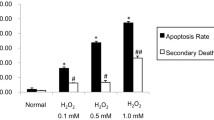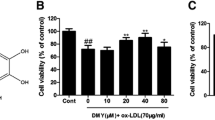Abstract
Understanding apoptosis regulatory mechanisms in endothelial cells (ECs) has great importance for the development of novel therapy strategies for cancer and cardiovascular pathologies. An oxidative stress with the generation of reactive oxygen species (ROS) is a common mechanism causing ECs’ dysfunction and apoptosis. The generation of ROS can be triggered by various stimuli including photodynamic therapy (PDT). In most PDT treatments, photosensitizer (PS) is administered systemically, and thus, possibility of high exposure to PS in the ECs remains high. PS accumulation in ECs may be clinically relevant even without PDT, if PS molecules affect the pro-apoptotic cascade without illumination. In the present work, we focused on Hypericin (Hyp) and HypPDT effects on the cell viability, oxidative stress, and the distribution of Bcl2 family members in human coronary artery endothelial (HCAEC) cells. Our findings show that the presence of Hyp itself has an effect on cell viability, oxidative stress, and the distribution of Bcl2 family members, without affecting the mitochondria function. In contrast, HypPDT resulted in mitochondria dysfunction, further increase of oxidative stress and effect on the distribution of Bcl2 family members, and in primarily necrotic type of death in HCAEC cells.







Similar content being viewed by others
References
Berlanda, J., Kiesslich, T., Engelhardt, V., Krammer, B., & Plaetzer, K. (2010). Comparative in vitro study on the characteristics of different photosensitizers employed in PDT. Journal of Photochemistry and Photobiology B-Biology, 100, 173–180.
Bechet, D., Mordon, S. R., Guillemin, F., & Barberi-Heyob, M. A. (2014). Photodynamic therapy of malignant brain tumours: A complementary approach to conventional therapies. Cancer Treatment Reviews, 40, 229–241.
Kepp, O., Senovilla, L., Vitale, I., Vacchelli, E., Adjemian, S., Agostinis, P., et al. (2014). Consensus guidelines for the detection of immunogenic cell death. Oncoimmunology, 3, e955691.
Miskovsky, P. (2002). Hypericin-a new antiviral and antitumor photosensitizer: Mechanism of action and interaction with biological macromolecules. Current Drug Targets, 3, 55–84.
Gyenge, E. B., Luscher, D., Forny, P., Antoniol, M., Geisberger, G., Walt, H., et al. (2013). Photodynamic mechanisms induced by a combination of hypericin and a chlorin based-photosensitizer in head and neck squamous cell carcinoma cells. Photochemistry and Photobiology, 89, 150–162.
Kascakova, S., Nadova, Z., Mateasik, A., Mikes, J., Huntosova, V., Refregiers, M., et al. (2008). High level of low-density lipoprotein receptors enhance hypericin uptake by U-87 MG cells in the presence of LDL. Photochemistry and Photobiology, 84, 120–127.
Kiesslich, T., Krammer, B., & Plaetzer, K. (2006). Cellular mechanisms and prospective applications of hypericin in photodynamic therapy. Current Medicinal Chemistry, 13, 2189–2204.
Agostinis, P., Vantieghem, A., Merlevede, W., & de Witte, P. A. M. (2002). Hypericin in cancer treatment: more light on the way. International Journal of Biochemistry & Cell Biology, 34, 221–241.
Theodossiou, T. A., Hothersall, J. S., De Witte, P. A., Pantos, A., & Agostinis, P. (2009). The multifaceted photocytotoxic profile of hypericin. Molecular Pharmaceutics, 6, 1775–1789.
Vantieghem, A., Xu, Y., Assefa, Z., Piette, J., Vandenheede, J. R., Merlevede, W., et al. (2002). Phosphorylation of Bcl-2 in G(2)/M phase-arrested cells following photodynamic therapy with hypericin involves a CDK1-mediated signal and delays the onset of apoptosis. Journal of Biological Chemistry, 277, 37718–37731.
Buytaert, E., Callewaert, G., Hendrickx, N., Scorrano, L., Hartmann, D., Missiaen, L., et al. (2006). Role of endoplasmic reticulum depletion and multidomain proapoptotic BAX and BAK proteins in shaping cell death after hypericin-mediated photodynamic therapy. Faseb Journal, 20, 756.
Krammer, B., & Verwanger, T. (2012). Molecular response to hypericin-induced photodamage. Current Medicinal Chemistry, 19, 793–798.
Kocanova, S., Buytaert, E., Matroule, J. Y., Piette, J., Golab, J., de Witte, P., & Agostinis, P. (2007). Induction of heme-oxygenase 1 requires the p38(MAPK) and PI3 K pathways and suppresses apoptotic cell death following hypericin-mediated photodynamic therapy. Apoptosis, 12, 731–741.
Galanou, M. C., Theodossiou, T. A., Tsiourvas, D., Sideratou, Z., & Paleos, C. M. (2008). Interactive transport, subcellular relocation and enhanced phototoxicity of hypericin encapsulated in guanidinylated liposomes via molecular recognition. Photochemistry and Photobiology, 84, 1073–1083.
Reeves, K. J., Reed, M. W. R., & Brown, N. J. (2009). Is nitric oxide important in photodynamic therapy? Journal of Photochemistry and Photobiology B-Biology, 95, 141–147.
Assefa, Z., Vantieghem, A., Declercq, W., Vandenabeele, P., Vandenheede, J. R., Merlevede, W., et al. (1999). The activation of the c-Jun N-terminal kinase and p38 mitogen-activated protein kinase signaling pathways protects HeLa cells from apoptosis following photodynamic therapy with hypericin. Journal of Biological Chemistry, 274, 8788–8796.
Itoh, K., Ishii, T., Wakabayashi, N., & Yamamoto, M. (1999). Regulatory mechanisms of cellular response to oxidative stress. Free Radical Research, 31, 319–324.
Volanti, C., Hendrickx, N., Van Lint, J., Matroule, J. Y., Agostinis, P., & Piette, J. (2005). Distinct transduction mechanisms of cyclooxygenase 2 gene activation in tumour cells after photodynamic therapy. Oncogene, 24, 2981–2991.
Huntosova, V., Nadova, Z., Dzurova, L., Jakusova, V., Sureau, F., & Miskovsky, P. (2012). Cell death response of U87 glioma cells on hypericin photoactivation is mediated by dynamics of hypericin subcellular distribution and its aggregation in cellular organelles. Photochemical & Photobiological Sciences, 11, 1428–1436.
English, D. S., Doyle, R. T., Petrich, J. W., & Haydon, P. G. (1999). Subcellular distributions and excited-state processes of hypericin in neurons. Photochemistry and Photobiology, 69, 301–305.
Uzdensky, A. B., Ma, L. W., Iani, V., Hjortland, G. O., Steen, H. B., & Moan, J. (2001). Intracellular localisation of hypericin in human glioblastoma and carcinoma cell lines. Lasers in Medical Science, 16, 276–283.
Siboni, G., Weitman, H., Freeman, D., Mazur, Y., Malik, Z., & Ehrenberg, B. (2002). The correlation between hydrophilicity of hypericins and helianthrone: internalization mechanisms, subcellular distribution and photodynamic action in colon carcinoma cells. Photochemical & Photobiological Sciences, 1, 483–491.
Theodossiou, T., Spiro, M. D., Jacobson, J., Hothersall, J. S., & MacRobert, A. J. (2004). Evidence for intracellular aggregation of hypericin and the impact on its photocytotoxicity in PAM 212 murine keratinocytes. Photochemistry and Photobiology, 80, 438–443.
Ali, S. M., & Olivo, M. (2002). Bio-distribution and subcellular localization of Hypericin and its role in PDT induced apoptosis in cancer cells. International Journal of Oncology, 21, 531–540.
Hsu, Y. T., Wolter, K. G., & Youle, R. J. (1997). Cytosol-to-membrane redistribution of Bax and Bcl-X-L during apoptosis. Proceedings of the National Academy of Sciences of the United States of America, 94, 3668–3672.
Korsmeyer, S. J. (1999). BCL-2 gene family and the regulation of programmed cell death. Cancer Research, 59, 1693s–1700s.
Lindsten, T., Ross, A. J., King, A., Zong, W. X., Rathmell, J. C., Shiels, H. A., et al. (2000). The combined functions of proapoptotic Bcl-2 family members Bak and Bax are essential for normal development of multiple tissues. Molecular Cell, 6, 1389–1399.
Annis, M. G., Zamzami, N., Zhu, W. J., Penn, L. Z., Kroemer, G., Leber, B., & Andrews, D. W. (2001). Endoplasmic reticulum localized Bcl-2 prevents apoptosis when redistribution of cytochrome c is a late event. Oncogene, 20, 1939–1952.
Nutt, L. K., Pataer, A., Pahler, J., Fang, B. L., Roth, J., McConkey, D. J., & Swisher, S. G. (2002). Bax and Bak promote apoptosis by modulating endoplasmic reticular and mitochondrial Ca2+ stores. Journal of Biological Chemistry, 277, 9219–9225.
Lindsay, J., Esposti, M. D., & Gilmore, A. P. (2011). Bcl-2 proteins and mitochondria-specificity in membrane targeting for death. Biochimica Et Biophysica Acta-Molecular Cell Research, 1813, 532–539.
Bonneau, B., Prudent, J., Popgeorgiev, N., & Gillet, G. (2013). Non-apoptotic roles of Bcl-2 family: The calcium connection. Biochimica Et Biophysica Acta-Molecular Cell Research, 1833, 1755–1765.
Ruvolo, P. P., Deng, X. M., Carr, B. H., & May, W. S. (1998). A functional role for mitochondrial protein kinase C alpha in Bcl2 phosphorylation and suppression of apoptosis. Journal of Biological Chemistry, 273, 25436–25442.
Kurinna, S., Konopleva, M., Palla, S. L., Chen, W., Kornblau, S., Contractor, R., et al. (2006). Bcl2 phosphorylation and active PKC alpha are associated with poor survival in AML. Leukemia, 20, 1316–1319.
Chowdhury, P. K., Ashby, K. D., Datta, A., & Petrich, J. W. (2000). Effect of pH on the fluorescence and absorption spectra of hypericin in reverse micelles. Photochemistry and Photobiology, 72, 612–618.
Wu, M., Neilson, A., Swift, A. L., Moran, R., Tamagnine, J., Parslow, D., et al. (2007). Multiparameter metabolic analysis reveals a close link between attenuated mitochondrial bioenergetic function and enhanced glycolysis dependency in human tumor cells. American Journal of Physiology-Cell Physiology, 292, C125–C136.
Brand, M. D., & Nicholls, D. G. (2011). Assessing mitochondrial dysfunction in cells. Biochemical Journal, 435, 297–312.
Dranka, B. P., Benavides, G. A., Diers, A. R., Giordano, S., Zelickson, B. R., Reily, C., et al. (2011). Assessing bioenergetic function in response to oxidative stress by metabolic profiling. Free Radical Biology and Medicine, 51, 1621–1635.
Bolte, S., & Cordelieres, F. P. (2006). A guided tour into subcellular colocalization analysis in light microscopy. Journal of Microscopy-Oxford, 224, 213–232.
Stupakova, V., Varinska, L., Mirossay, A., Sarissky, M., Mojzis, J., Dankovcik, R., et al. (2009). Photodynamic effect of hypericin in primary cultures of human umbilical endothelial cells and glioma cell lines. Phytotherapy Research, 23, 827–832.
Martinez-Poveda, B., Quesada, A. R., & Medina, M. A. (2005). Hypericin in the dark inhibits key steps of angiogenesis in vitro. European Journal of Pharmacology, 516, 97–103.
Sureau, F., Miskovsky, P., Chinsky, L., & Turpin, P. Y. (1996). Hypericin-induced cell photosensitization involves an intracellular pH decrease. Journal of the American Chemical Society, 118, 9484–9487.
Haimovitz-Friedman, A., Balaban, N., McLoughlin, M., Ehleiter, D., Michaeli, J., Vlodavsky, I., & Fuks, Z. (1994). Protein kinase C mediates basic fibroblast growth factor protection of endothelial cells against radiation-induced apoptosis. Cancer Research, 54, 2591–2597.
Gill, M. B., & Perez-Polo, J. R. (2009). Bax shuttling after rotenone treatment of neuronal primary cultures: Effects on cell death phenotypes. Journal of Neuroscience Research, 87, 2047–2065.
Infante, S. K., Oberhauser, A. F., & Perez-Polo, J. R. (2013). Bax phosphorylation association with nucleus and oligomerization after neonatal Hypoxia-ischemia. Journal of Neuroscience Research, 91, 1152–1164.
Lindenboim, L., Ferrando-May, E., Borner, C., & Stein, R. (2013). Non-canonical function of Bax in stress-induced nuclear protein redistribution. Cellular and Molecular Life Sciences, 70, 3013–3027.
Kutuk, O., & Letai, A. (2008). Alteration of the mitochondrial apoptotic pathway is key to acquired paclitaxel resistance and can be reversed by ABT-737. Cancer Research, 68, 7985–7994.
Vogler, M., Hamali, H. A., Sun, X. M., Bampton, E. T. W., Dinsdale, D., Snowden, R. T., et al. (2011). BCL2/BCL-X-L inhibition induces apoptosis, disrupts cellular calcium homeostasis, and prevents platelet activation. Blood, 117, 7145–7154.
Yoshioka, J., Chutkow, W. A., Lee, S., Kim, J. B., Yan, J., Tian, R., et al. (2012). Deletion of thioredoxin-interacting protein in mice impairs mitochondrial function but protects the myocardium from ischemia-reperfusion injury. Journal of Clinical Investigation, 122, 267–279.
Herrmann, A. G., Deighton, R. F., Le Bihan, T., McCulloch, M. C., Searcy, J. L., Kerr, L. E., & McCulloch, J. (2013). Adaptive changes in the neuronal proteome: mitochondrial energy production, endoplasmic reticulum stress, and ribosomal dysfunction in the cellular response to metabolic stress. Journal of Cerebral Blood Flow and Metabolism, 33, 673–683.
Ho, J. H., de Moura, M. B., Lin, Y., Vincent, G., Thorne, S., Duncan, L. M., et al. (2012). Importance of glycolysis and oxidative phosphorylation in advanced melanoma. Molecular Cancer, 11, 1.
Kramer, P. A., Ravi, S., Chacko, B., Johnson, M. S., & Darley-Usmar, V. M. (2014). A review of the mitochondrial and glycolytic metabolism in human platelets and leukocytes: Implications for their use as bioenergetic biomarkers. Redox Biology, 2, 206–210.
Acknowledgments
Supported by the EU 7FP grant PIRG06-GA-2009-256580 and by EU Structural Fund ITMS26110230013; by the Slovak Grant Agency VEGA -1-0111-12 and VEGA 1/0425/15; and by the Slovak Research and Development Agency APVV-0134-11.
Author information
Authors and Affiliations
Corresponding author
Rights and permissions
About this article
Cite this article
Maslaňáková, M., Balogová, L., Miškovský, P. et al. Anti- and Pro-apoptotic Bcl2 Proteins Distribution and Metabolic Profile in Human Coronary Aorta Endothelial Cells Before and After HypPDT. Cell Biochem Biophys 74, 435–447 (2016). https://doi.org/10.1007/s12013-016-0740-y
Received:
Accepted:
Published:
Issue Date:
DOI: https://doi.org/10.1007/s12013-016-0740-y




